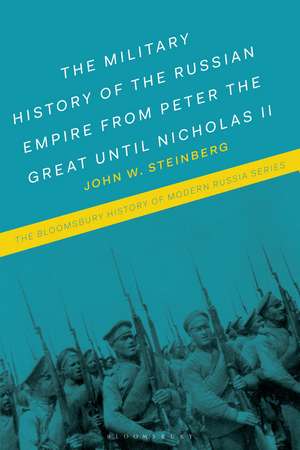The Military History of the Russian Empire from Peter the Great until Nicholas II: The Bloomsbury History of Modern Russia Series
Autor Professor John W. Steinbergen Limba Engleză Hardback – 7 feb 2024
Preț: 513.20 lei
Preț vechi: 732.84 lei
-30% Nou
Puncte Express: 770
Preț estimativ în valută:
98.20€ • 105.01$ • 81.88£
98.20€ • 105.01$ • 81.88£
Carte tipărită la comandă
Livrare economică 17 aprilie-01 mai
Preluare comenzi: 021 569.72.76
Specificații
ISBN-13: 9781350037182
ISBN-10: 1350037184
Pagini: 342
Ilustrații: 10 bw illus
Dimensiuni: 156 x 234 x 24 mm
Greutate: 0.66 kg
Editura: Bloomsbury Publishing
Colecția Bloomsbury Academic
Seria The Bloomsbury History of Modern Russia Series
Locul publicării:London, United Kingdom
ISBN-10: 1350037184
Pagini: 342
Ilustrații: 10 bw illus
Dimensiuni: 156 x 234 x 24 mm
Greutate: 0.66 kg
Editura: Bloomsbury Publishing
Colecția Bloomsbury Academic
Seria The Bloomsbury History of Modern Russia Series
Locul publicării:London, United Kingdom
Caracteristici
Case studies in every chapter provide valuable, concise overviews and assessments of key Russian battles
Notă biografică
John W. Steinberg is Professor of History at Austin Peay State University, USA. He is the author of All the Tsar's Men: Russia's General Staff and the Fate of the Empire, 1898-1914 (2010) and the co-editor, along with Rex A. Wade, of The Making of Russian History: Society, Culture, and the Politics of Modern Russia (2009). He is also co-series editor, with Tony Heywood and David M. McDonald, of the international research project 'Russia's Great War & Revolution'.
Cuprins
List of MapsIntroduction1. Russia's Emergence in World Affairs (1689-1725)2. Romanovs, Aristocrats, and the Creation of the Russian Empire (1725-1796)3. The Defeat of Napoleon and the Apex of Empire (1796-1853)4. From Defeat to Defeat; From Reform to Reform (1853-1918)5. Russian Power Restored (1918-1953)6. Soviet Imperium (1953-1991)Epilogue: Russian Power since 1991 and Future ConsiderationsBibliographyIndex
Recenzii
This scope of this volume is breathtaking. It builds on a wealth of recent scholarship to present an evolutionary overview of Russian strategy and military affairs in their full historical context. More than a study of leaders and campaigns, coverage extends from the situations and conditions that spawned armed conflict to the social elements and institutions that enabled it.











